LEITZ COMPOUND MICROSCOPE
c. 1883
SIGNED ON THE ARM: E. LEITZ,WETZLAR, No 5625
SERIAL NUMBER: 5625 (on the arm and in the case)
MODEL:STAND No. III (later No. IV)
Author: Barry Sobel
Editor: Joseph Zeligs
Please Click On Any Picture for a
Larger Version
DESCRIPTION:
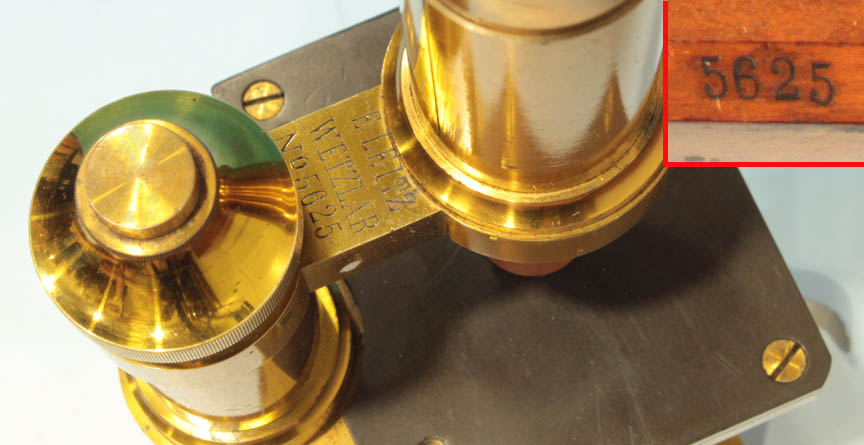 This is a fine example of the Leitz No. III Stand from about 1883. It is signed on the arm:
This is a fine example of the Leitz No. III Stand from about 1883. It is signed on the arm: E. LEITZ,WETZLAR, No 5625
and the serial number is also on the inside of the case. It is built on a horseshoe (a.k.a. continental) foot. The continental limb supports a monocular optical tube with a draw tube. The tube accepts Continental size eyepieces. Coarse focusing adjustment is by push-pull. The fine adjustment is via a knurled knob at the top of the pillar. The smaller diameter part of the knob will adjust the focus more quickly than the larger part, thus providing a type of two speed
fine focus. As anyone who has used this type of knob is aware, although it is all one piece, the smaller diameter part will rotate its screw much further with the same effort.
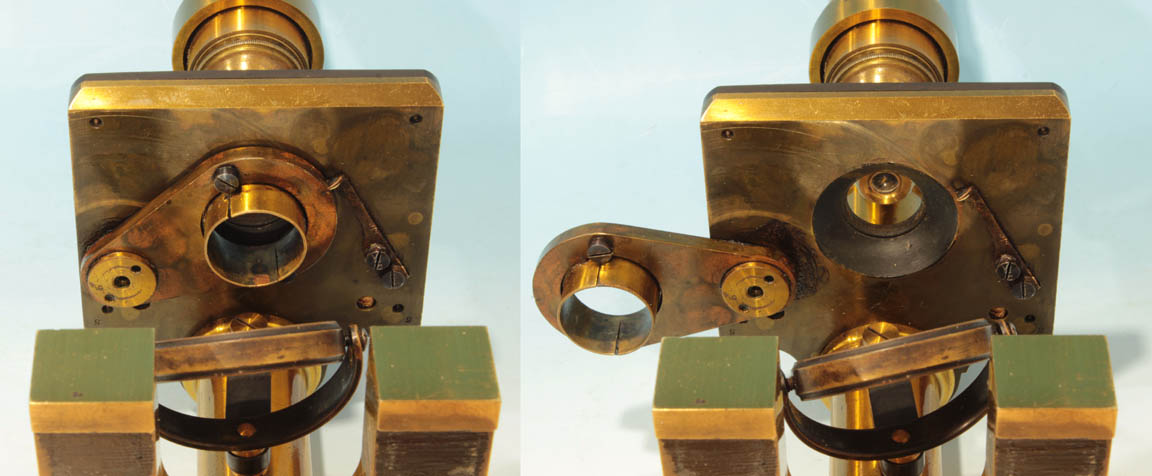
The stage has a hard rubber surface. The two nickel-silver stage clips are removable. A sleeve attached to the bottom of the stage can swivel out of the axis and away from the stage and accepts substage accessories such as the cylinder which can carry any 1 of the three apertures. There is a click stop to hold the substage sleeve in the centered position. The swinging tailpiece carries a plano and concave mirror fixed to its end.
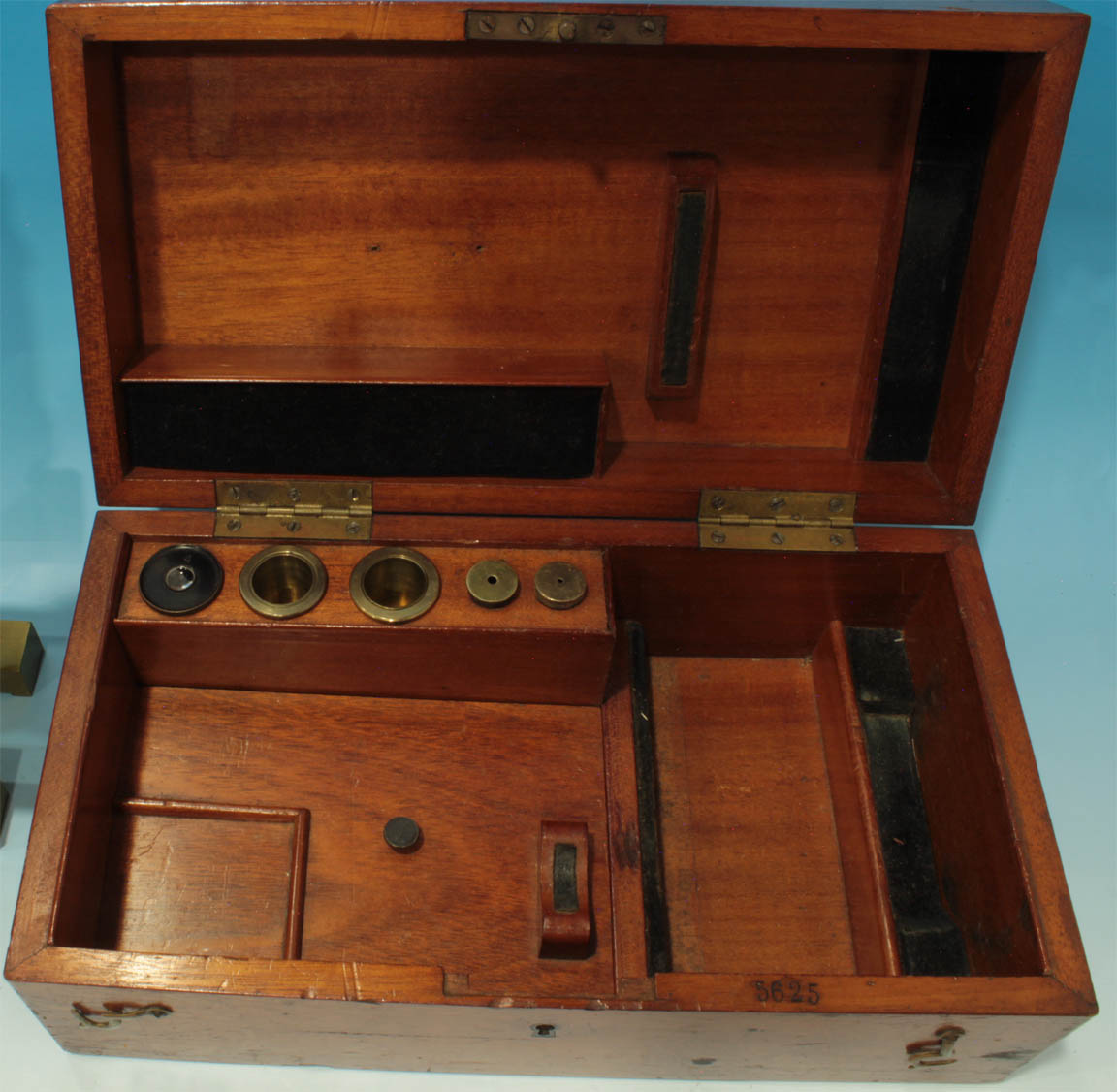
The microscope came in its original hardwood case with matching serial number. The fitted case accepts the microscope and has wooden fixtures for the eyepieces and cylinder stops and also in this example carries two eyepiece adapters for different size eyepieces. The microscope rests on a wooden board which has a support for the limb, a knob to lift it out, and a square pocket which would have accepted a leather-covered case for the objectives (objective case not present). The pocket is formed by two small wooden ledges on the board and two sides of the case.
ACCESSORIES:
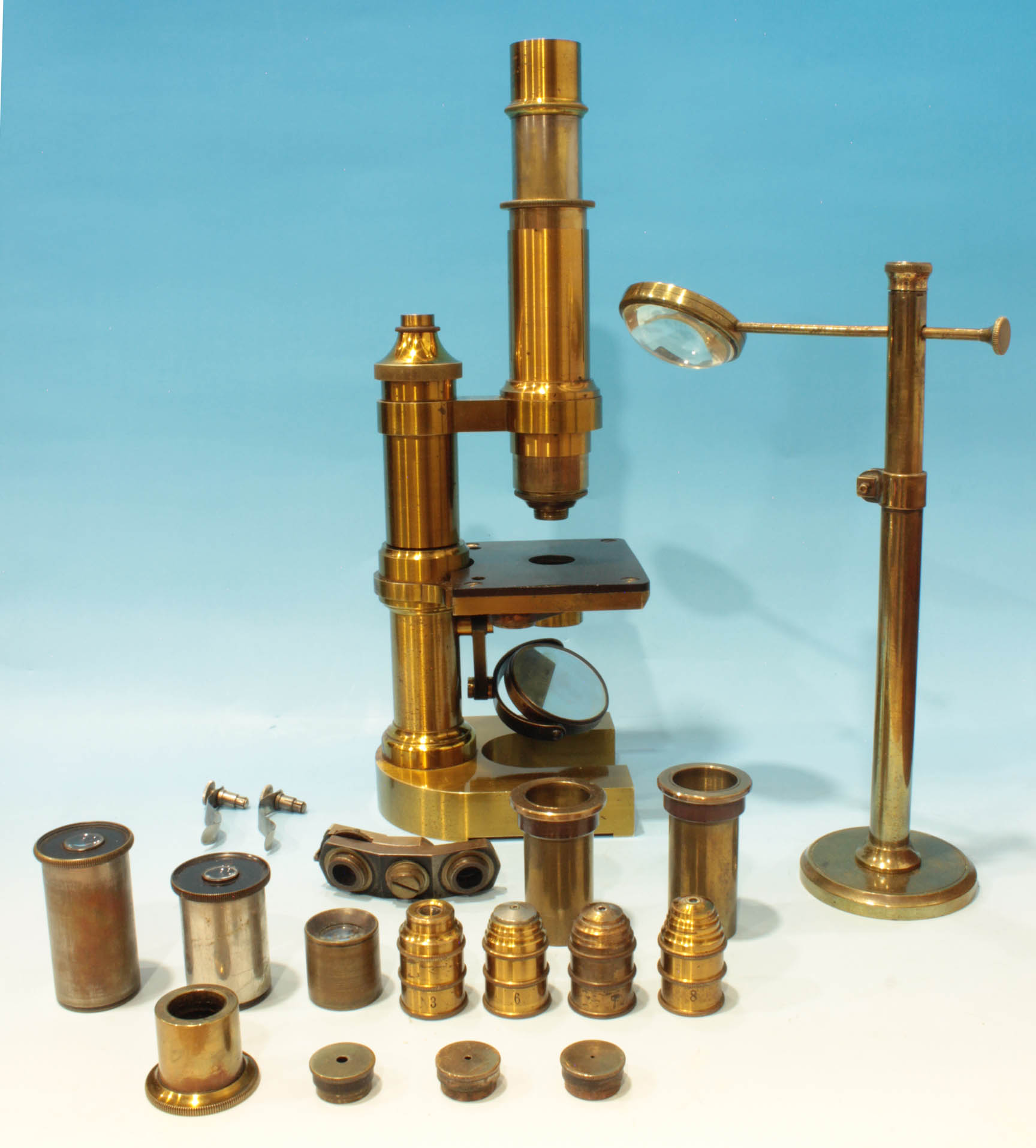
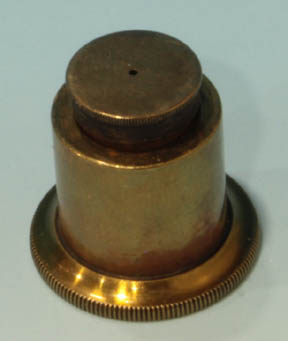
Accessories include 4 objectives, two eyepieces, the substage cylinder(right) for any of the 3 apertures, a bullseye bench condenser and a double nosepiece objective changer. The objectives are numbered 3,6,7 and 8. According to 1885 Leitz catalog, the number 3 is the lowest power (about 9X), numbers 6,7,and 8 are 34X, 47X, and 60X respectively and are all meant to be used dry. It should be noted that Leitz used these numbers to designate different (higher) magnifications later on.
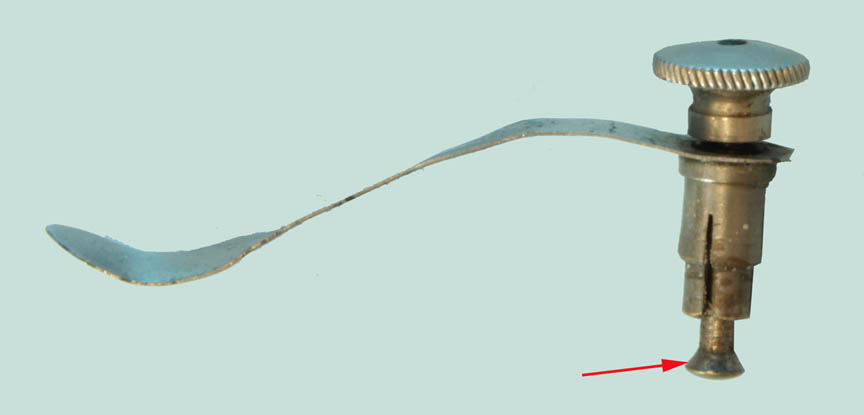 The two removeable stage clips have a tightening device that allows them to be fixed in the stage holes. As the knob is tightened on a rod which is threaded, it pulls the cone-shaped end of the rod (red arrow) into the hollow housing which is split, expanding the housing inside the hole in the stage, thus griping it securely. There is also a bench condenser with adjustable height included. It has a knob on top of the vertical extension which tightens on the stem holding the condenser lens, to fix its horizontal position.
The two removeable stage clips have a tightening device that allows them to be fixed in the stage holes. As the knob is tightened on a rod which is threaded, it pulls the cone-shaped end of the rod (red arrow) into the hollow housing which is split, expanding the housing inside the hole in the stage, thus griping it securely. There is also a bench condenser with adjustable height included. It has a knob on top of the vertical extension which tightens on the stem holding the condenser lens, to fix its horizontal position.
CONDITION:
Overall this smaller microscope is in very good condition. There are some tiny losses of lacquer throughout and an area of loss on the drawtube near the eyepiece opening. The original case is in good condition except for missing the leather case for the objectives and lock and key.
HISTORY OF THE LEITZ No. III & SIMILAR MICROSCOPES
The model featured on this page was sold equipped as shown on this page above from about 1880 through 1916 or later. It was no longer listed in the 1923 Leitz Catalog.
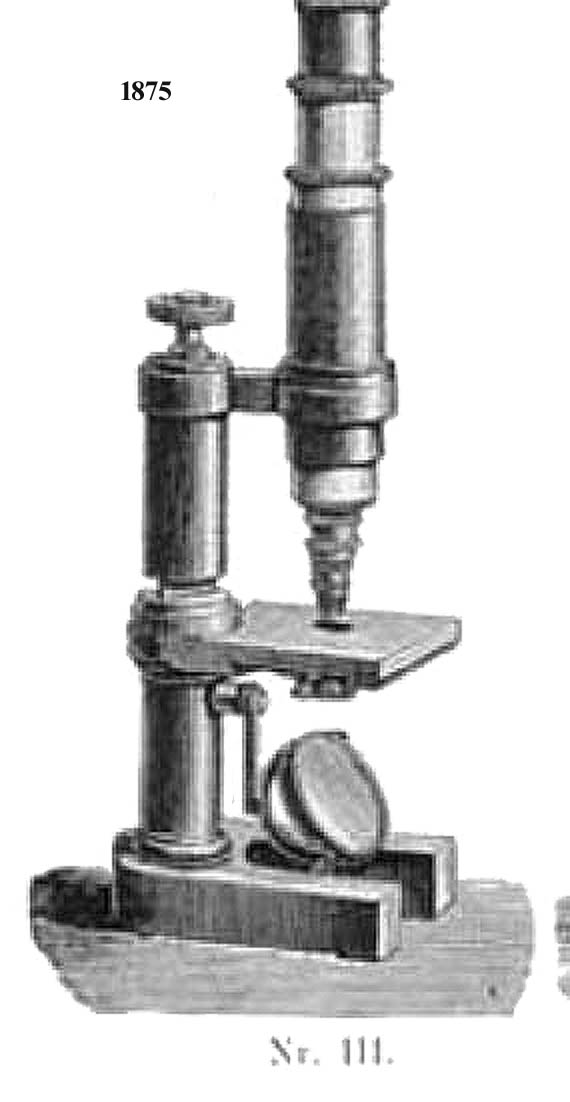
I begin the story of this microscope in 1875, the earliest catalog I have access to. A similar model, but with a simpler fine focus knob was listed as the No. III in the 1875 catalog.
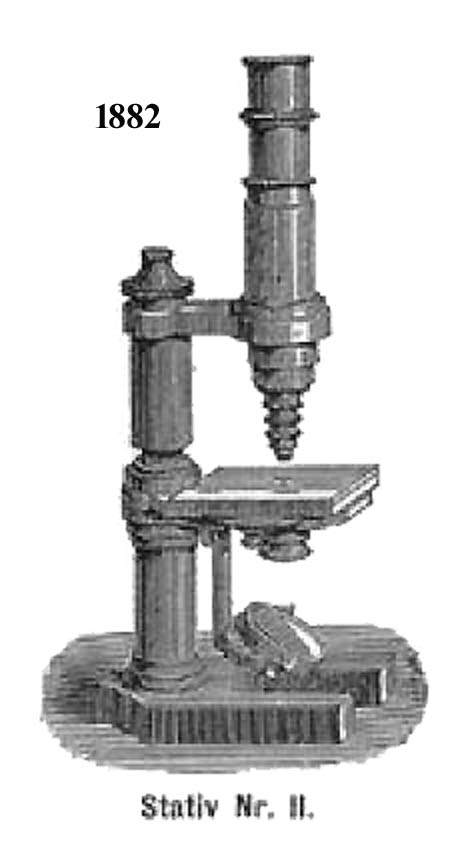
In the 1880 and 1882 catalogs the model as featured on this page was sold as the medium size
No. II.
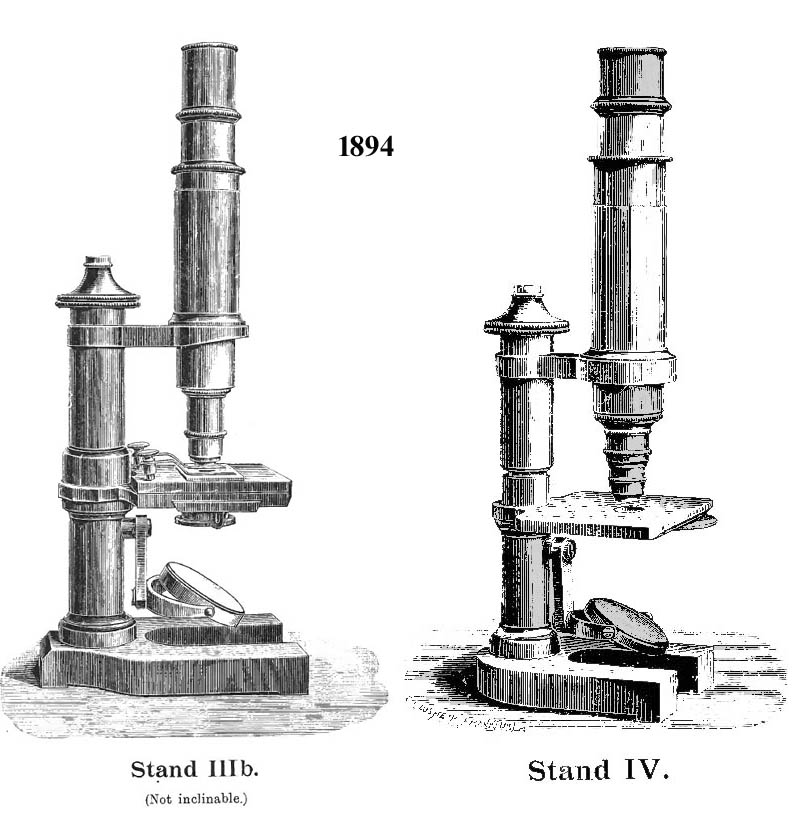
In 1885 and 1888 stand No. III appeared virtually identical to the current example (see comparitive illustration at top). I 1892, 1894, ad 1899, similar stands (with slight modifications were sold as the No. III or the No. 3b. In these years, the foot became more Y-shaped instead of U-shaped as it was earlier.
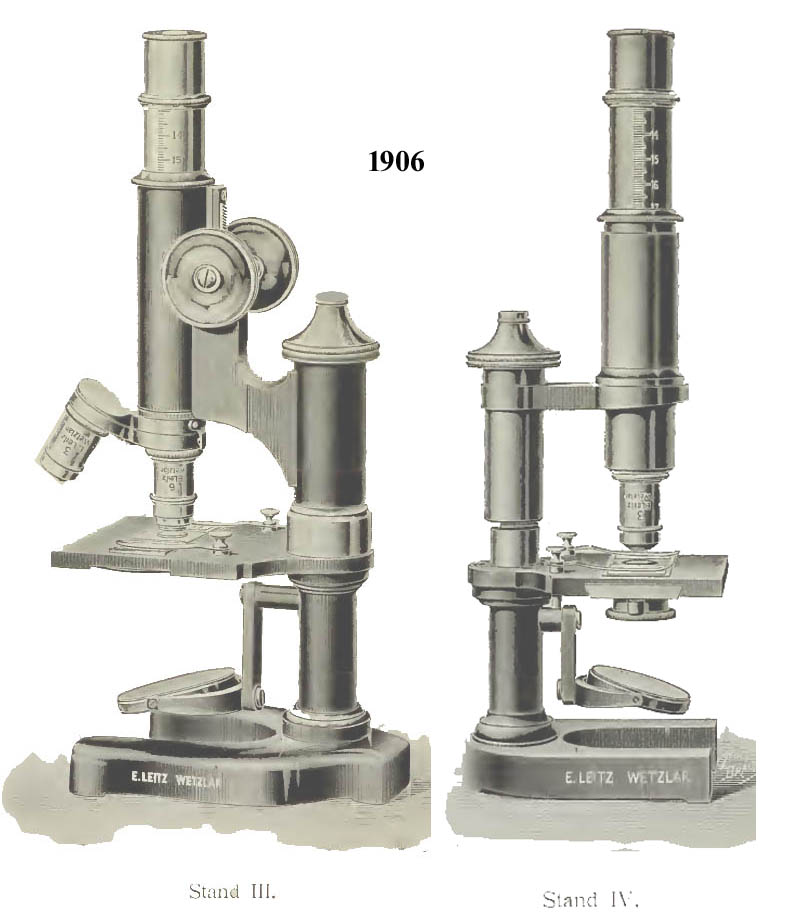
From 1906 to 1913 stands similar to the earlier No. III were sold as the No. IV model. Draw tube calibration was added no later than 1899, and from about 1906 onward, these models had a blackened finish.
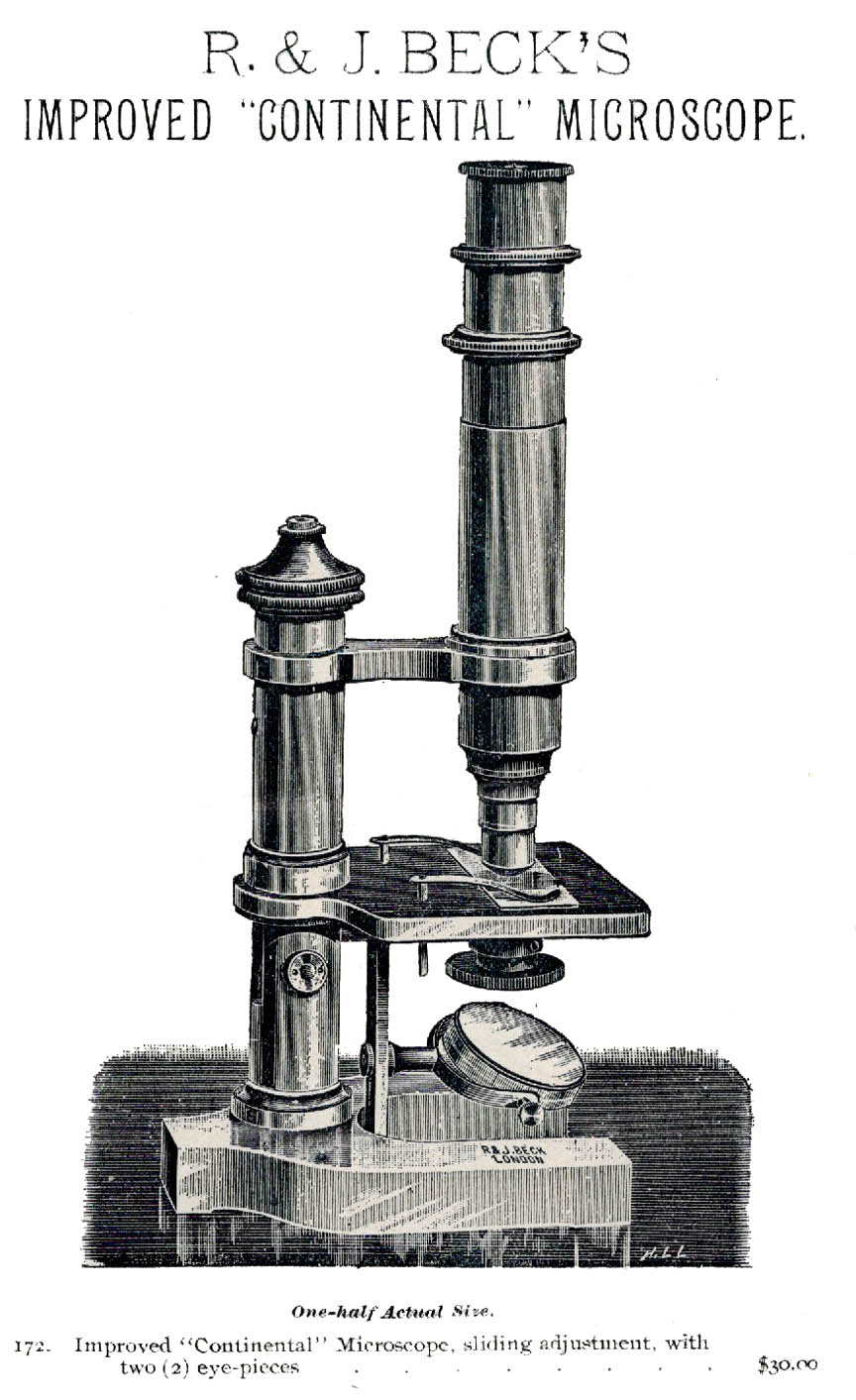 From the 1870s until well into the 20th Century most of the famous scientific users of the microscope were German. These included Robert Koch who cultured the bacillus causing Antrax and showed that it caused that disease in the 1870s. Koch also discovered the bacteria that causes tuberculosis in 1882. Another German, Virchow popularized the notion of the dysfunction of cells in disease. These famous scientists reported their use of German continental style microscopes. These then became quite popular in colleges and universities that sought to train the students using the same kinds of microscopes. As continental microscopes became more popular, the English and Americans copied the design to compete with the Europeans, especially the Germans. An example very similar to the Leitz No. III made by R&J Beck is shown here to the left. You will note the only substantial differences compared to the Leitz No. 3 are that the instrument has an inclination joint, and the mirror not only is on a swinging tailpiece but, unlike the Leitz No. III it can be also be moved up or down that tailpiece.
From the 1870s until well into the 20th Century most of the famous scientific users of the microscope were German. These included Robert Koch who cultured the bacillus causing Antrax and showed that it caused that disease in the 1870s. Koch also discovered the bacteria that causes tuberculosis in 1882. Another German, Virchow popularized the notion of the dysfunction of cells in disease. These famous scientists reported their use of German continental style microscopes. These then became quite popular in colleges and universities that sought to train the students using the same kinds of microscopes. As continental microscopes became more popular, the English and Americans copied the design to compete with the Europeans, especially the Germans. An example very similar to the Leitz No. III made by R&J Beck is shown here to the left. You will note the only substantial differences compared to the Leitz No. 3 are that the instrument has an inclination joint, and the mirror not only is on a swinging tailpiece but, unlike the Leitz No. III it can be also be moved up or down that tailpiece.
 This is a fine example of the Leitz No. III Stand from about 1883. It is signed on the arm:
This is a fine example of the Leitz No. III Stand from about 1883. It is signed on the arm: 



 The two removeable stage clips have a tightening device that allows them to be fixed in the stage holes. As the knob is tightened on a rod which is threaded, it pulls the cone-shaped end of the rod (red arrow) into the hollow housing which is split, expanding the housing inside the hole in the stage, thus griping it securely. There is also a bench condenser with adjustable height included. It has a knob on top of the vertical extension which tightens on the stem holding the condenser lens, to fix its horizontal position.
The two removeable stage clips have a tightening device that allows them to be fixed in the stage holes. As the knob is tightened on a rod which is threaded, it pulls the cone-shaped end of the rod (red arrow) into the hollow housing which is split, expanding the housing inside the hole in the stage, thus griping it securely. There is also a bench condenser with adjustable height included. It has a knob on top of the vertical extension which tightens on the stem holding the condenser lens, to fix its horizontal position. 



 From the 1870s until well into the 20th Century most of the famous scientific users of the microscope were German. These included Robert Koch who cultured the bacillus causing Antrax and showed that it caused that disease in the 1870s. Koch also discovered the bacteria that causes tuberculosis in 1882. Another German, Virchow popularized the notion of the dysfunction of cells in disease. These famous scientists reported their use of German continental style microscopes. These then became quite popular in colleges and universities that sought to train the students using the same kinds of microscopes. As continental microscopes became more popular, the English and Americans copied the design to compete with the Europeans, especially the Germans. An example very similar to the Leitz No. III made by R&J Beck is shown here to the left. You will note the only substantial differences compared to the Leitz No. 3 are that the instrument has an inclination joint, and the mirror not only is on a swinging tailpiece but, unlike the Leitz No. III it can be also be moved up or down that tailpiece.
From the 1870s until well into the 20th Century most of the famous scientific users of the microscope were German. These included Robert Koch who cultured the bacillus causing Antrax and showed that it caused that disease in the 1870s. Koch also discovered the bacteria that causes tuberculosis in 1882. Another German, Virchow popularized the notion of the dysfunction of cells in disease. These famous scientists reported their use of German continental style microscopes. These then became quite popular in colleges and universities that sought to train the students using the same kinds of microscopes. As continental microscopes became more popular, the English and Americans copied the design to compete with the Europeans, especially the Germans. An example very similar to the Leitz No. III made by R&J Beck is shown here to the left. You will note the only substantial differences compared to the Leitz No. 3 are that the instrument has an inclination joint, and the mirror not only is on a swinging tailpiece but, unlike the Leitz No. III it can be also be moved up or down that tailpiece.